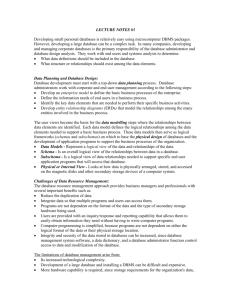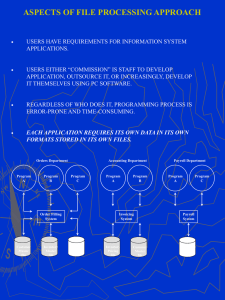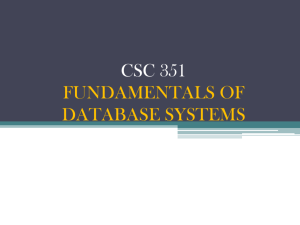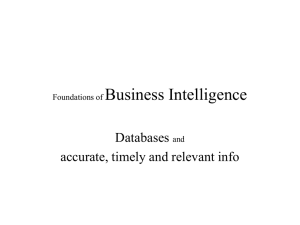Kroenke-Auer-Chapter1 - Department of Information Systems • NJIT
advertisement
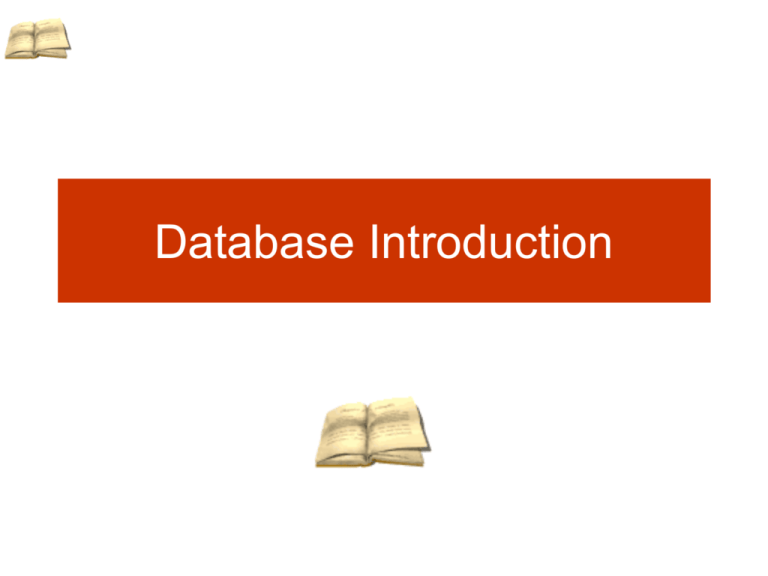
Database Introduction
Objectives
• To understand the nature and characteristics of databases
• To survey some important and interesting database
applications
• To gain a general understanding of tables and relationships
• To define the term database management system (DBMS)
and describe the functions of a DBMS
• To define the term database and describe what is contained
within the database
• To define the term metadata and provide examples of
metadata
• To define and understand database design from existing data
TRADITIONAL FILE
PROCESSING SYSTEMS
CASE STUDY: Sleepy Valley High School
Information Split Among
Different Departments
• We will look at the offices at Sleepy Valley
H.S. who keep files on the teachers at
Sleepy Valley
Principal's Office
Assistant Principal's Office
Personnel Department
Payroll department
Where is data stored?
The Principal, Mr. Halprin, uses a
regular notebook.
The Assistant Principal, Ms. Lewis, uses
index cards.
The Personnel Office Director, Ms.
Lauren, uses a Windows word processing
program.
The Payroll Office Director, Mr. Smith,
uses a Lotus 1-2-3 Spreadsheet.
Principal
Mr. Halprin is the
Principal
He keeps two very
important files on
teachers:
A Teacher File with current
data on all teachers.
A Job History File for every
teacher who has taught at
the school.
Teachers
Degree
Dept.
Code
• 001
Mr. Halprin's
Teacher
FileRd.
Sill, Bill
1 Apple
M.A.
3
Lan, Jackie 18 Lord Rd.
M.A.
2
M.S.
5
M.A.
1
M.S.
3
M.S.
2
Teacher ID#
012
Teacher Name
Address
15 Pine
Terrace
014
James, Hal
027
Lan, Hennie 20 Lord Rd.
035
Gold, Amy
041
Doe, Jon
21 Deer
Lane
4 High
Street
Pay Scale
ID#
SCALE
• Mr. Halprin's Job History File
001
001
001
012
014
014
027
035
042
044
2
3
4
4
1
2
1
3
2
1
DATE ATTAINED
9/15/1995
9/15/1996
9/15/2001
12/15/2008
1/15/1999
9/15/2002
9/15/1994
1/15/1987
9/15/1995
9/1/1996
Why maintain data?
One reason is REPORTS.
The world demands REPORTS.
For Mr. Halprin, the Teachers
Union demands an annual salary
report, giving for each teacher their
salary scale history.
Teacher Salary Scale
Information
Teach. ID
Name
Address
Degreee
Current
Scale
• 001
Teacher's
Job
History
Report
Sill, Bill
1 Apple
M.A.
4
Road
Scale
Date
2
3
4
9/15/95
9/15/96
9/15/01
012
Lan, Jackie
18 Lord
Rd.
M.A.
4
4
12/15/08
014
James, Hal
15 Pine
Terrace
M.S.
2
1
2
1/15/99
9/15/02
Assistant Principal
Ms. Lewis is the Asst.
Principal
One of her
assignments is to
maintain a "Speakers
List"
She maintains 2 files
– Teacher-Speaker
File
– Seminar Topic File
Speaker File
Teacher ID
Teacher
Name
Teacher
Address
• Ms.
Lewis'
Teacher
File
001
Sill, Bill
1 Apple Rd.
Highest
Degree
Home Phone
M.A.
648-2174
012
Lan, Jackie
18 Lord Rd.
Ph.D.
334-9392
014
James, Hal
15 Pine Terrace
M.S.
647-1267
027
Lan, Hennie
20 Lord Rd.
M.A.
325-1111
035
Silver, Amy
65 Bliss Ave.
M.S.
246-1342
042
Doe, John
4 High Street
M.S.
371-1994
Do You See Any Problems With
these different files?
• Look closely at Teacher ID 35 in both Mr.
Halprin’s Teacher File, and Ms. Lewis’s
Teacher File?
– Can you explain the differences?
– Why did they occur?
– Is this a desirable feature for this file
processing system?
• Also look at the “Doe’s” in both Teacher
Files.
Seminar Information
Teacher ID
Seminar Title
Audience Level
Date Last Given
001
Crisis in Bosnia
H-So
1/8/2003
H-Jr
5/2/2009
• Ms. Lewis' Seminar
Topic File
Shakespeare's
012
Poetry
014
Finding Primes
H-Fr
10/4/2001
014
Non-Euclidean
Geometry
C-So
4/15/2002
014
Digital Photography
H-Sr.
11/1/2002
027
Modern Portugese
Poetry
H-Fr
4/4/2002
035
Hypergeometric
Invariant
transformations
C-Sr
5/3/2003
Personnel Office
Ms. Lauren directs
the Personnel Office
Among several files,
she maintains the
following 2 files
Personnel Teachers File
Insurance Plan File
Teacher / Medical Plan
Teacher ID
Dependent
Teacher name Medical Plan #
Coverage ?
001
Sill,
Bill
• Personnel's
Teacher
File
3
N
012
Lan, Jackie
3
Y
014
James, Hal
1
Y
027
Lan, Hennie
2
N
035
Silver, Amy
2
Y
042
Doe, John
4
Y
Medical Plan Information
Medical Plan #
Plan Name
1
Best Medical
2
Good Health
3
USMEDCO
4
National Medical
5
Republic Care
• Insurance File
Payroll Office
Mr. Smith is the
Director of the
Payroll Office
Mr. Smith maintains
two files of interest to
us
–a
Teacher Master File
– a Department File
Salary
Teach. Name
Address Zip Code Salary
ID
• Payroll Dept's Teacher File
001
Sill, Bill 1 Apple 07102
$54,613
Rd.
012
Lan,
18 Lord 07122
$46,215
Jackie Rd.
014
James, 17 Main 07145
$48,112
Hal
Street
027
Lan,
20 Lord 07104
$44,000
Hennie Rd.
035
Gold,
21 Dear 07103
$42,465
Amy
Lane
042
Doe,
4 High
07102
$40,810
John
Street
Year to Dept. #
date
$27,502
3
$28,102
2
$24,016
5
$22,032
4
$26,217
5
$25,419
5
Payroll's Department File
Dept #
1
2
Dept. Name
Science
English
Dept. Loc.
207
315
Phone Ext.
3111
3164
3
Social Studies
117
3152
215
3123
461
3154
4
5
Foreign
Languages
Mathematics
File Processing Problems
Redundancy (duplication of data)
• wasteful of space (storage)
• update inefficiencies
(when a teacher moves to a new address, or
changes her name, the teacher's "record" must
be changed each place it is stored)
• data inconsistency (different addresses for the same
teacher in different files)
Legacy Programs
Programs to work on these files at Sleepy Valley
H.S.
The Payroll Department has written some
lengthy Pascal programs to access their files
and perform queries and reports.
The Personnel Department has written some C
programs to access their files and perform
queries and reports.
Sleepy Valley H.S. - continued
The Board of Education asks the Principal to
provide a report giving:
•
For EACH department,
list separately the scale 1,2,3 and 4 teachers
the date of promotion to current rank for each
teacher
the seminar topics for each teacher.
How To Create the Board of
Education requested report
We must access files from 3 different offices,
since no single office has all the files needed to
create this report
• From the Payroll Office files, we can obtain, for
each Department, the teachers' names and id's
and departments
• From the Principal's Office Files, we can obtain,
for each teacher, the current salary scale and
date this salary scale became effective
• From the Asst. Principal's Office files, we can
obtain the seminar topics for each teacher.
A Potential Solution…
Build a SINGLE pool of interrelated files, rather
than SEPARATE collection of files.
•
(This is an INFORMAL description of a database).
The Teacher File in a Database
ID#
-
NAM
ADD
SALARY YTD
DEPT #
DEG
SCL
INS
DEP
001Sill, Bill 1 Apple
54613
27500
3
M.A.
4
3
N
012Lan,
Jacki
18 Lord
Rd.
46215
24256
2
PhD
4
3
Y
014etc.-
-
-
-
-
-
-
-
-
-
How would other files appear?
The other files would have the identical structure
(scheme) as they had in their original
departments.
•
•
•
•
•
The Department File from Payroll
The Insurance File from Personnel
The Seminar Topic File from the Asst. Principal
The Job History file from the Principal's Office
etc.
The DEPARTMENT "schema"
Dept #
Dept. Name
Dept. Loc.
Dept. Phone
1
2
3
Science
207
3111
or
(Dept#, Deptname, DeptLoc, Phone)
Important Notes:
We eliminate redundancy in the database
by listing each teacher only once.
The report requested by the Board of
Education is much easier to produce, as all
of the needed data is present in the single
database.
The teacher "table" has "relationships" with
other "tables."
Why Use A Database?
(Summary)
• The purpose of a database is to help people
and organizations keep track of things
• Problems of using list to store data
– Data inconsistencies
– Data privacy: The departments want to share
some, but not all, of their data
• Databases store data in single-theme tables
• Tables are related through primary and
foreign keys
Database Theory: Entities,
Attributes and Relationships
An ENTITY is an object that exists and is
distinguishable
.
from other objects.
•
"a person, place or thing"
Examples of entities include individual teachers,
departments, seminar topics, etc.
An ENTITY SET is the set of all entities of the
same type.
•
ALL of the teachers at Sleepy Valley HS constitute
an ENTITY SET. Each individual teacher is an
ENTITY
Database Theory: Attributes
An ATTRIBUTE is a defining property or quality
of an entity (we will see that relationships will be
permitted to have attributes also)
•
•
Attributes of Teachers might include their id#,
address, degree, department #, etc.
Attributes of Departments might include their
name, room#, telephone, chairman, etc.
The DOMAIN OF AN ATTRIBUTE will be the set
of allowable values for an attribute.
Database Theory: Relationships
A RELATIONSHIP is an association between
entities in different entity sets.
–
There is a RELATIONSHIP between entities
(teachers) in the TEACHER entity set and entities
(departments) in the DEPARTMENT entity set,
namely each teacher (e.g., Jackie Lan), is
associated with a given department (English)
A MAPPING CARDINALITY is the number of
entities to which another entity can be
associated with in a relationship.
Lakeview Equipment List
Lakeview List Issues
• Four “themes” in the list (Jobs, Contactors,
Equipment, & Rentals)
• Suppose KH Services changes its phone# ?
• Suppose we delete RB Partnership’s row?
• Can a new contractor be added if there is no
rental?
• What about the missing data for the
scaffolding rental?
• Are the different daily rental rates for the
backhoe rental valid?
Four themes – four tables?
• JOB (Name,…)
• CONTRACTOR (Contractor, Phone,…)
• EQUIPMENT(EquipmentType,
EquipmentNumber, Dailyrate,…)
• RENTAL (StartDate, EndDate, Days,…)
Unique Identifiers, Relationships
• JOB (JobID, Name)
• CONTRACTOR (ContractorID, Contractor,
Phone, Street, City, State, Zip)
• EQUIPMENT (EquipmentID,
EquipmentType, EquipmentNumber,
DailyRate)
• RENTAL (ID, JobID, ContractorID,
EquipmentID, StartDate, EndDate, Days)
Populated Lakeview Database Tables in
Microsoft Access, With Relationships
Sample SQL Query
Database Definition
A Database is a structure
that can house information
about multiple types of
entities, as well as
relationships among the
entities.
Database System Components
DBMS
• DBMS: Database Management System
– Create database, tables, and supporting
structures
– Read and update database data
– Maintain database structures
– Enforce rules
– Control concurrency
– Provide security
– Perform backup and recovery
• Examples: Oracle, DB2, Microsoft Access,
SQL Server
Database
• Database is a self-describing collection of
related records or tables
– User Data
– Metadata: data about the structure of a database
– Indexes and related structures
– Stored procedures: program modules stored
within the database
– Triggers: a procedure that is executed when a
particular data activity occurs
– Application metadata: data describing application
elements such as forms and reports
Kroenke-Auer Definition of a
Database (Important!)
"A database is a
self-describing
collection of
integrated records."
An Analogy
Is a Library a collection of books and periodicals?
• A Library also contains a card-catalog, which
describes the books in the Library.
So, a Library might be considered a selfdescribing collection of books and
periodicals.
Self Describing
In addition to source data, a database
contains a description of its own
structure.
– This
description is referred to as either:
a data dictionary
a data directory
metadata
Different Types of Databases
Typical Size
Typical Number of
of
Concurrent Users
Database
Type
Example
Personal
Mary Richards
House Painting
1
< 10 megabytes
Work Group
Treble Clef Music
<25
<100 megabytes
Organizational
Licensing &
Registration
Hundreds to
Thousands
1 Trillion Bytes
Mary Richards House Painting
CUSTOMER( CUST-ID, CustomerName, Street,
City, State, Zip, PhoneNumber, SOURCE-ID)
JOB( JOB-ID, JobDate, Description, AmtBilled,
AmtPaid, CUST-ID)
SOURCE( SOURCE-ID, Name, PhoneNumber)
Sea View Yacht Sales - Work
Group
BOAT-TYPE(BOAT-TYPE-ID, Description, NewPurchasePrice,
NumberPurchased)
SAILBOAT(SAILBOAT-ID, BoatName, DateListed, Year, AskingPrice,
CurrentLocation, Description, BOAT-TYPE-ID)
EQUIPMENT( EQUIPMENT-ID, ItemName, Item-Desc, SAILBOAT-ID)
SALESPERSON(SALESPERSON-ID, Name, AreaCode,
LocalNumber)
CUSTOMER(CUSTOMER-ID, Custname, AreaCode, LocalNum,
Street, City, State, Zip, Notes, SALESPERSON-ID)
CUSTOMER-BOAT-INT(CUSTOMER-ID, BOAT-TYPE-ID)
CUSTOMER-SAILBOAT-INT( CUSTOMER-ID, SAILBOAT-ID)
Database Management System
A Database Management System (DBMS) is a
software product through which users interact
with a database.
•
By "interact with a database" we mean the user
can create, edit, query, produce reports, and
perform other functions with a database.
Desktop Database History
• Ashton Tate (1979) introduces dBase II
• In 1980's, dBase, Paradox and Foxpro are the
"major players"
• Microsoft buys out Foxpro
• Borland (Paradox) buys out Ashton-Tate
• Windows versions of DBMS products appear
• Microsoft brings out Access 1.0 at price of $99
• Currently MS Access is most widely used
microcomputer database product.
Relational Database Model
Developed by E. F. Codd in 1970
Based upon concepts in a branch of
mathematics called Relational Algebra
A (simple) methodology for structuring and
processing a database
Data is stored (conceptually) as tables.
•
Relationships between tables are "visible" in the
data
Sample Student & Course
Tables
StudentName
Phone
100
200
300
Jones, Mary
Parks, Franklin
Thomas, Martha
323-0098
232-9987
887-4484
Course#
CourseName
Semester
Grade
StudentId
BD100
BA402
F
S
A
C
100
200
S
B
200
BD100
BD200
BA150
Intro MIS
Accting
Seminar
Mgmt
Principles
Intro MIS
Database
Intro to Accting
F
S
F
C
B
B
300
300
100
MA102
Intro Calculus
F
B
100
CS100
Intro Comp Sci
F
A
300
BF315
Example of a Data Model
Departments Write to Single DB
Payroll
• Programs
Personnel
Programs
Without a DBMS, we would
still have individual
departments writing their
own programs to directly
interact with the database
Database
Principal's
Programs
Interacting with the database
through the DBMS
Payroll
Database
Personnel
Management
System
Principal
Database
Database Views
A VIEW is some subset of the database which a
DBMS permits a particular user, or set of users,
to see.
• {It is actually the Database Administrator who
decides upon the views.}
Another name for a view is a subschema (a
subset of a schema).
Teacher Database
ID#
NAM
ADD
SALARY YTD
001Sill, Bill 1 Apple
SCL
INS
DEP
44613
17500
3
M.A.
4
3
N
012Lan,
18 Lord 36215
Jacki Rd.
14256
2
PhD
4
3
Y
-
-
-
-
-
014etc.-
DEPT # DEG
-
-
-
-
Student Database
ID#
•
-
NAM
ADD
DEPT # DEG
SCL
INS
DEP
A View of the Teacher Database with NO
Salary Information
001Sill, Bill 1 Apple
3
M.A.
4
3
N
012Lan,
Jacki
18 Lord
Rd.
2
PhD
4
3
Y
014etc.-
-
-
-
-
-
-
-
DB View Benefits
provides the user with a "simpler" structure
containing only relevant information
protects sensitive data from users who should
not be allowed to see such data
note that a dbms will permit other security
features, such as password protection, so a
user may be able to view salary data, but not
edit any changes in salary data
A Second DBMS Feature
Most DBMS allow you to specify INTEGRITY
CONSTRAINTS on attribute values (i.e., you can
specify the domain of an attribute)
•
Example: you can specify that SALARY for a
teacher be numeric, non-negative and below
$123,456.
Specifying integrity constraints provides some
protection against data-entry errors.
Database Designers have a primary concern to
maintain the integrity of the database.
Relational Databases
• The purpose of a database is to help people and organizations
track things of interest to them
• A relational database stores data in tables, which have rows and
columns (like a spreadsheet). A database typically has many
different tables, where each table stores data about a different thing
• Each row in a table stores data about an occurrence or instance of
the thing of interest (an entity) – rows are also known as records.
• A column of a table stores an attribute common to all of the rows in
a table.
– For example, in a STUDENT table, we might have
columns/attributes for firstname, lastname, major, GPA,
emailaddress, etc.
• A database stores data and other things.
A Student Table and a Class
Table
A Database Has Data and
Relationships
• A database contains both data (stored in
tables) and relationships between the data
in the tables.
• There could be several types of
relationships between data.
Tables have Relationships
• Notice That The Tables Below Do Not
Have Explicit Relationships, And Thus The
Grades in the Grade Table Are
Meaningless
Naming Conventions
• Table Names are written with all capital
letters:
– STUDENT, CLASS, GRADE
• Column names are written with an initial
capital letter, and compound names are
written with a capital letter on each word:
– Term, Section, ClassNumber, StudentName
Adding Relationships
• We link data in one table with data in another table and form
relationships.
• The links are accomplished by having an attribute in one table
point to an attribute in another table.
• Each row in a table has an attribute (or set of attributes) which
serves as the unique identifier, known as the primary key.
– So, in the STUDENT table, the attribute StudentNumber serves as the
primary key, while the attribute ClassNumber serves as the primary
key of the CLASS table.
– Could ClassName serve as the primary key of the CLASS table?
(Answer is “No” – do you see why?)
– Could LastName serve as the primary key of the STUDENT table? Will
LastName ALWAYS uniquely identify a record????
– Could EmailAddress serve as a primary key? (What if a student did not
have an email address?)
Foreign Keys
• A foreign key is an attribute in one table
which point to an attribute in another table.
• Foreign keys enable us to form
relationships between tables.
Database (With Relationships)
For Students & Grades
Databases Create Information
From Data
• Data = Recorded facts and figures
• Information = Knowledge derived from data, i.e.,
data presented in a meaningful context, where we
may have applied some form of processing to the
data, such as computing averages, sorting,
grouping, etc.
• Databases record data, but they do so in such a
way that we can produce information from the data
– The data on STUDENTs, CLASSes and GRADEs
could produce information about each student’s
GPA
Database Examples
Types of Databases
• Single User Database Applications
– Supports only one user at a time
• Multi-User Database Applications
– Supports multiple users concurrently
• E-Commerce Database Applications
• Similar database design concepts are
apropos to the above types.
Components of a Database
Systems
• A database system generally contains 4
components:
– Users (from end-users to database administrators
– The database application
– The Database Management System (such as
Microsoft Access, Oracle, etc.)
– The data (the collection of facts stored in the
database)
• Aside : databases systems will also have metadata
(data about data) and procedures/rules which
govern the overall design and usage of the
database
What is a DBMS (Database
Management System)?
• A DBMS (Database Management System) is a collection of
programs that manages the database structure and controls
access to the data stored in the database
• The DBMS is the intermediary between the user and the
database – it receives requests from users, and translates
them into the operations required to fulfill those requests
– The DBMS makes it possible to share data among multiple
applications or users
– The DBMS hides much of the database’s internal complexity
from end-users
– The DBMS makes data management more efficient and effective
The Components
Components of a DBMS Using
SQL
SQL (Structured Query Language) is an internationally
recognized language used by commercial DBMS products –
database applications typically send SQL statements to the
DBMS for processing.
Summary: Database
Applications, DBMS, and SQL
• Applications are the computer programs
that users work with
• The Database Management System
(DBMS) creates, processes and
administers databases
• Structured Query Language (SQL) is an
internationally recognized standard
database language that is used by all
commercial DBMSs
Some Prominent DBMS
Products
•
•
•
•
•
Microsoft Access
Microsoft SQL Server
IBM DB2
Oracle Corporation’s ORACLE
MySQL
DBMS Power vs. Ease of Use
Database Applications and SQL
• Some typical functions of database
application programs
– Create and process forms for entering data
• The form presents the data entry details in an easy-to-use format
• Behind the form, the Application generates the requisite SQL
statements to insert and update the data for any of the tables
underlying the form
– Process user queries (a query is a question the user asks of a
database)
• The Application processes the query and sends it to the DBMS
– Create and process reports for the end-user
• The Application queries (using SQL) the DBMS for data needed in
the report, and formats the query results according to the end-user
specifications.
An Example Data Entry Form
for Our Student-Class Database
Producing Reports
• A Class Grade Report might be generated
as follows:
Processing an SQL Query
We present an SQL query to list the first name, last
name and email address of all students having a student
number >2 .
(We will cover SQL later, this is only a small preview)
SELECT
Lastname, Firstname, EmailAddress
FROM STUDENT
WHERE
StudentNumber > 2;
The result might look like:
The Database Summary
• DEFINITION: A database is a self-describing
collection of integrated tables
• The tables are called integrated because they
store both end-user data and the relationships
among the data.
• A database is called self-describing because it
stores a description of itself
• The self-describing data are called metadata,
which means “data about data”
– (The form and format of metadata varies between
different DBMS products.)
Why a “self-describing”
collection?
– To understand this definition, if you were asked to
define a Library, would it be reasonable to say a
Library is a collection of books and periodicals?
• If yes, if we were to pile up 5,000 books and
periodicals in a stack in a room, would that be a
Library? (No !)
– What makes a Library a true Library is the
organizational structure of the books and periodicals,
and the fact that a true Library will have a card
catalog which will enable us to locate a book (or
periodical).
– So, in fact, a Library should be defined as a selfdescribing collection of books and periodicals.
Typical Metadata Tables in User
/ Class Example
Query Metadata, Just As Query
“Regular” Tables of Data
• Example: The following SQL queries the metadata table
SYSOBJECTS to determine if a user table
(Type = ‘U’) named CLASS exists in the database, and,
if yes, that table will be removed from the database.(
Note : reminder that the syntax will be more meaningful
after we study SQL – this is merely a preview)
IF EXISTS
(SELECT
*
FROM
SYSOBJECTS
WHERE
[Name] = ‘CLASS’
AND
Type= ‘U’)
DROP TABLE CLASS;
Database Design
Database design is the most crucial activity in
database development, and involves
designing the proper structure of tables,
the proper relationships among tables,
the appropriate data constraints,
and other structural components.
Poorly designed databases are very
problematic, and thus much of this course is
devoted to reviewing the principles behind
optimal database design.
The Three Types of Database
Design
• From Existing Data
– Analyze Spreadsheets and other data tables
– Extract data from other databases
– Design using normalization principles
• New Systems Development
– Create data model from application requirements
– Transform data model into a database design
• Database Redesign
– Migrate databases to newer databases
– Integrate two of more databases
– Reverse engineer and design a new database using
normalization principles and data model transformation
Database Design From Existing
Data
• Often involves importing data from already existing
spreadsheets or other files with tables of data.
• The data might also arise from an existing
operational database, such as a CRM or ERP
application, and will be brought into a new database
specifically used for analysis and research. The
existing database might arise from a data
warehouse.
• Database designers must design the appropriate
structure for the new database.
Databases Originating From
Existing Data
A Common Issue in Creating a
Database from Existing Data
• How should multiple tables and files from the existing
data be handled in the new database? Should a single
table be maintained as a single table?
Resolving the Design Issue
from Existing Data
• Database designers follow a rigorous set
of design principles, called Normalization
or Normal Forms, which guide us to
optimal database designs.
• Normalization is discussed later
Database Design for New
Systems Development
• In the development of new information systems for business
enterprises, government and organizations, databases are often
designed “from scratch.”
• The databases are predicated on the database designer’s
specification of user forms and the reports to be produced for the
organization.
• Part of database design is eliciting and specifying User
Requirements
• A data model is designed to graphically portray the User
Requirements. The data model is then transformed into a database
design.
– Data models, such as Entity Relationship (ER) data modeling,
are also studied along with how to transform our data models
into database designs which can then be implemented.
Databases Designed for New
Information Systems
Database Redesign
• Databases often need to be adapted to
new or changing requirements (often
referred to as database migration).
• We often need to integrate two (or more)
databases, such as when adapting or
removing legacy systems, or in enterprise
application integration, where previously
separate information systems are adapted
to work with each other.
Database Redesign
The Relational Database Model
• The dominant database model is the relational
database model, which is based upon tables of data
(called relations) – all current major DBMS products
are based on it
• Created by E. F. Codd in 1970
• It was based on a mathematical theory called
Relational Algebra
• Focus is on the relational database model.


